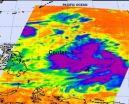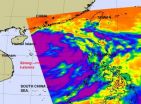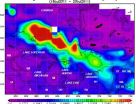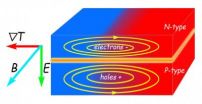(Press-News.org) WORCESTER, Mass. – Escape responses are some of the most studied behaviors by neurobiologists who want to understand how the brain processes sensory information. The ability to evade predators plays a vital role in the process of natural selection. Animals explore their environment to find food, find mates and locate new habitats, and have developed distinct escape responses to avoid predators, thereby increasing their chances for survival. Yet there are few examples that illustrate a complete understanding of the basic biological mechanisms of behavior with its ecological relevance.
New research by scientists at the University of Massachusetts Medical School (UMMS) published this week in Current Biology offers evidence that for the first time illuminates a biological and ecological path that links genes to molecule to neural circuit to behavior to environment. "We're studying how the nervous system generates behavior and translates sensory information into a coordinated motor output," said Mark Alkema, PhD, assistant professor of neurobiology at UMMS and lead author of the study. "For example, when you try to swat a fly, it has to coordinate its leg lift and wing flapping in order to escape being crushed. We believe that the small roundworm C. elegans does something similar in its own escape-response."
A gentle touch to the head of the C. elegans causes the microscopic nematode to cease normal exploratory head movements and quickly reverse direction. This response is one of the rare examples where the complete path from sensory neuron to coordinated motor output is understood by scientists. What wasn't known, however, is why C. elegans would suppress exploratory head movements when touched on the head but not when touched on the nose or tail. While the C. elegans is commonly grown in petri dishes in laboratories, its normal habitat is in the soil. Dr. Alkema and his colleagues at UMMS hypothesized that the nematode adapted this singular behavior in response to predacious fungi found in its natural environment that use constricting rings to trap its prey.
"Predacious fungi and soil nematodes have a long predator-prey relationship that goes back more than 100 million years," said Alkema. "Predacious fungi have developed very sophisticated strategies to catch and devour nematodes. The most ingenious of these fungi use constricting rings that ensnare the nematode when it passes through the ring. But in the evolutionary arms race between the two organisms, the nematodes have found a way to escape these fungal nooses."
Though the fungi's ensnaring rings react quickly once the trap is triggered, there is a small delay that occurs during which the worm can carefully backup and escape the trap. Alkema suspected the suppression of head movements in response to touch would increase the microscopic worm's chances to escape from the deadly fungal noose.
To test the contribution of the head suppression gene in this predator-prey interaction, Sean Maguire, a research assistant, and Chris Clark, a PhD student, in Alkema's lab, performed competition experiments between mutant and normal nematodes. "What we found was that worms that couldn't suppress their head movements were caught much more efficiently than worms that could," said Clark. "This indicates that suppression of head movements provide a selective advantage to surviving fungal encounters in the natural environment for nematodes."
"This study raises the intriguing possibility that maybe this behavior has evolved as a result of selective pressures imposed by predacious fungi as part of an evolutionary arms race," said Alkema. "There is wide variety of nematodes with different escape behaviors. Since we know the neurotransmitters and receptors that control this behavior in C. elegans, we can start to understand how the environment has shaped the evolution of their behavior."
###
About the University of Massachusetts Medical School
The University of Massachusetts Medical School, one of the fastest growing academic health centers in the country, has built a reputation as a world-class research institution, consistently producing noteworthy advances in clinical and basic research. The Medical School attracts more than $255 million in research funding annually, 80 percent of which comes from federal funding sources. The mission of the Medical School is to advance the health and well-being of the people of the commonwealth and the world through pioneering education, research, public service and health care delivery with its clinical partner, UMass Memorial Health Care. For more information, visit www.umassmed.edu.
Elusive prey
Study shows that selection pressures imposed by predator fungi have shaped escape behavior in microscopic worms
2011-08-01
ELSE PRESS RELEASES FROM THIS DATE:
Geographic analysis offers new insight into coral disease spread
2011-08-01
GAINESVILLE, Fla. — In the last 30 years, more than 90 percent of the reef-building coral responsible for maintaining major marine habitats and providing a natural barrier against hurricanes in the Caribbean has disappeared because of a disease of unknown origin.
Now a University of Florida geographer and his colleagues applied Geographic Information Systems, known as GIS — as well as software previously used to examine human illness — to show where clusters of diseased coral exist. Their findings, published this month in the journal PLoS One, may help scientists derive ...
NASA identifies the areas of Tropical Storm Muifa's strength
2011-08-01
The strongest thunderstorms that make up tropical storm Muifa are on the storm's eastern and southern sides, according to infrared imagery from NASA's Aqua satellite. The northern side is being weakened by a nearby weather system.
Tropical Storm Muifa is moving through the western North Pacific Ocean, and had strengthened during the early morning hours of July 28. On July 27, it was tropical depression 11W and winds have since increased to 40 knots (46 mph/74 kmh).
When NASA's Aqua satellite passed over Tropical Storm Muifa the Atmospheric Infrared Sounder (AIRS) instrument ...
NASA eyes Tropical Storm Nock-Ten's heavy rains for Hainan Island and Vietnam
2011-08-01
Infrared satellite imagery from NASA's Aqua satellite shows bands of strong thunderstorms wrapping around the center of Tropical Storm Nock-Ten as it makes its way through the South China Sea and two landfalls on Hainan Island and in Vietnam.
Bands of strong thunderstorms that make up tropical storm Nock-ten were visible in an infrared image captured on July 28 by the Atmospheric Infrared Sounder (AIRS) instrument that flies on NASA's Aqua satellite. The colder the cloud tops, the higher the thunderstorms and the stronger they are, and cloud top temperatures over a large ...
NASA measures wildfire pollution pour over Niagara Falls
2011-08-01
Water isn't the only thing pouring over Niagara Falls. Pollution from fires in Ontario, Canada is also making the one thousand mile trip, while being measured by NASA's Aqua satellite.
One instrument that flies aboard two of NASA's satellites has provided two views of the pollution from the fires in Ontario. The Moderate Resolution Imaging Spectroradiometer, or MODIS instrument, flies onboard NASA's Aqua and Terra satellites. MODIS has provided a visible look at the smoke and pollution that has spread over Niagara Falls and east to Nova Scotia.
As of July 20, the Canadian ...
Cash Advances US Provides Fast Cash Loans Online With No Credit Check
2011-08-01
Less-than-perfect credit score can wipe off any opportunity to get some cash you need at the moment as most of the lenders consider people with bad credit history as high-risk borrowers. However, Cash Advances US offers particular cash loans with no credit check which are available online. The service was actually designed specially for consumers with damaged credit report who often face troubles applying for some extra money.
It's fast and simple to take out online payday advance loans performed by the company as the application process is held totally on the Internet. ...
Using a 'systems biology' approach to look under the hood of an aggressive form of breast cancer
2011-08-01
SEATTLE – Using a "systems biology" approach – which focuses on understanding the complex relationships between biological systems – to look under the hood of an aggressive form of breast cancer, researchers for the first time have identified a set of proteins in the blood that change in abundance long before the cancer is clinically detectable. The findings, by co-authors Christopher Kemp, Ph.D., and Samir Hanash, M.D., Ph.D., members of Fred Hutchinson Cancer Research Center's Human Biology and Public Health Sciences divisions, respectively, are published online ahead ...
SOHO watches a comet fading away
2011-08-01
On Nov. 4, 2010, NASA's EPOXI spacecraft came within 450 miles of Comet Hartley 2, a small comet not even a mile in diameter, which takes about six and a half years to orbit the sun. Designated officially as 103P/Hartley 2, the comet thus became the fifth for which scientists have collected close-up images.
But the comet was also observed from another spacecraft: the Solar and Heliospheric Observer (SOHO), better known for its observations of the sun. Together, the two returned data about what appears to be an irregular comet, belching chunks of ice and losing water at ...
Fresh Produce Clothing's Summer-Fall Collections Feature Unique Pieces of Wearable Works of Art
2011-08-01
Fresh Produce customers can make an artful statement when they wear the eclectic prints featured in its latest collections of effortless and spirited looks. The inspired prints are available in a variety of new styles and fabrications from cool cotton voile to comfy cotton jersey and versatile rayon-lycra.
This summer's standout print is the Blue Tahitian Flower. Fresh Produce women adore this romantic watercolor-inspired motif. Its look and feel is "pure summer" with beautiful tropical flowers captured in soft, watery hues and translated to new chic tunics, ...
An unexpected clue to thermopower efficiency
2011-08-01
Scientists at the U.S. Department of Energy's Lawrence Berkeley National Laboratory (Berkeley Lab) and their colleagues have discovered a new relation among electric and magnetic fields and differences in temperature, which may lead to more efficient thermoelectric devices that convert heat into electricity or electricity into heat.
"In the search for new sources of energy, thermopower – the ability to convert temperature differences directly into electricity without wasteful intervening steps – is tremendously promising," says Junqiao Wu of Berkeley Lab's Materials ...
Boloco Earns Another 'Green' Star
2011-08-01
Back in March 2008 boloco, a chain of inspired burrito restaurants, became the first fast-casual chain in New England to become a Certified Green Restaurant by the Green Restaurant Association (GRA). But when boloco found out an even higher level of certification could be achieved - well, let's just say they reached for the stars. Boloco is now the first chain* of restaurants to become a 2 Star Certified Green Restaurant across all of their 17 locations.
For each of boloco's 17 locations to earn the GRA's rigorous two-star certification, they had to be inspected and ...
LAST 30 PRESS RELEASES:
Sports injuries sustained during your period might be more severe
World's first successful 2 Tbit/s free-space optical communication using small optical terminals mountable on satellites and HAPS
Can intimate relationships affect your heart? New study says ‘yes’
Scalable and healable gradient textiles for multi‑scenario radiative cooling via bicomponent blow spinning
Research shows informed traders never let a good climate crisis go to waste
Intelligent XGBoost framework enhances asphalt pavement skid resistance assessment
Dual-function biomaterials for postoperative osteosarcoma: Tumor suppression and bone regeneration
New framework reveals where transport emissions concentrate in Singapore
NTP-enhanced lattice oxygen activation in Ce-Co catalysts for low-temperature soot combustion
Synergistic interface engineering in Cu-Zn-Ce catalysts for efficient CO2 hydrogenation to methanol
COVID-19 leaves a lasting mark on the human brain
Scientists use ultrasound to soften and treat cancer tumors without damaging healthy tissue
Community swimming program for Black youth boosts skills, sense of belonging, study finds
Specific depressive symptoms in midlife linked to increased dementia risk
An ‘illuminating’ design sheds light on cholesterol
Who is more likely to get long COVID?
Study showcases resilience and rapid growth of “living rocks”
Naval Research Lab diver earns Office of Naval Research 2025 Sailor of the Year
New Mayo-led study establishes practical definition for rapidly progressive dementia
Fossil fuel industry’s “climate false solutions” reinforce its power and aggravate environmental injustice
Researchers reveal bias in a widely used measure of algorithm performance
Alcohol causes cancer. A study from IOCB Prague confirms damage to DNA and shows how cells defend against it
Hidden viruses in wastewater treatment may shape public health risks, study finds
Unlock the power of nature: how biomass can transform climate mitigation
Biochar reshapes hidden soil microbes that capture carbon dioxide in farmland
Reducing saturated fat intake shows mortality benefit, but only in high-risk individuals
Manta rays create mobile ecosystems, study finds
Study: Mixed results in using lipoic acid to treat progressive multiple sclerosis
Norbert Holtkamp appointed director of Fermi National Accelerator Laboratory
New agentic AI platform accelerates advanced optics design
[Press-News.org] Elusive preyStudy shows that selection pressures imposed by predator fungi have shaped escape behavior in microscopic worms






